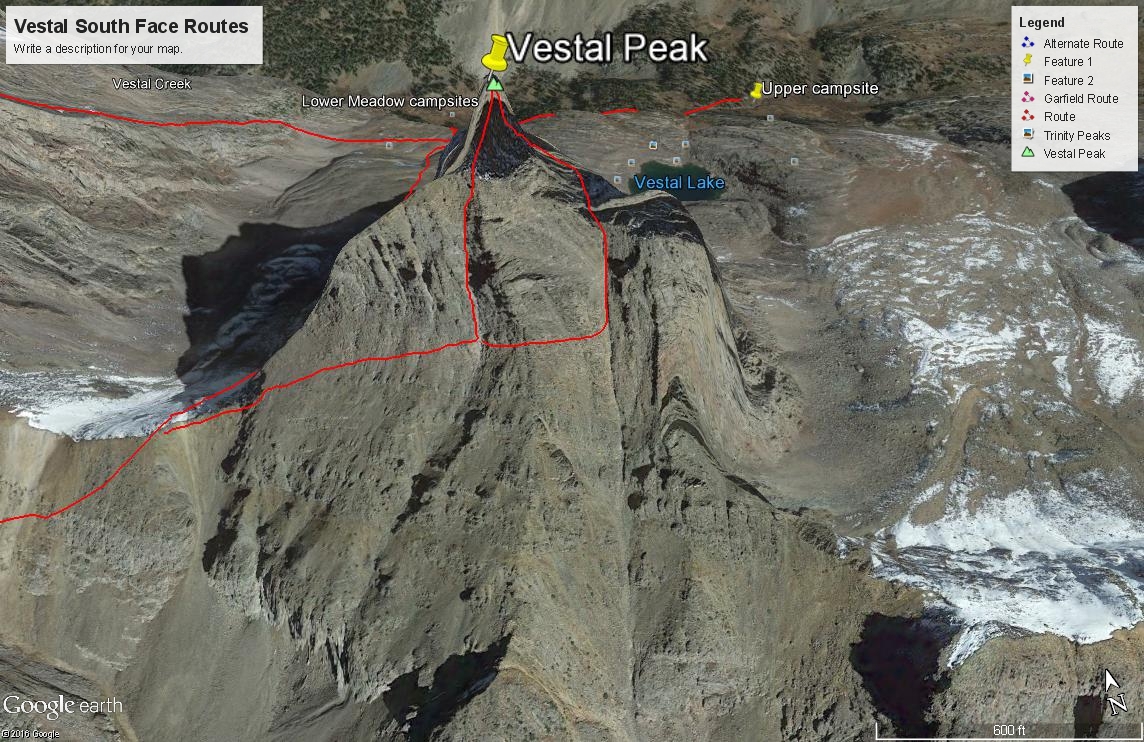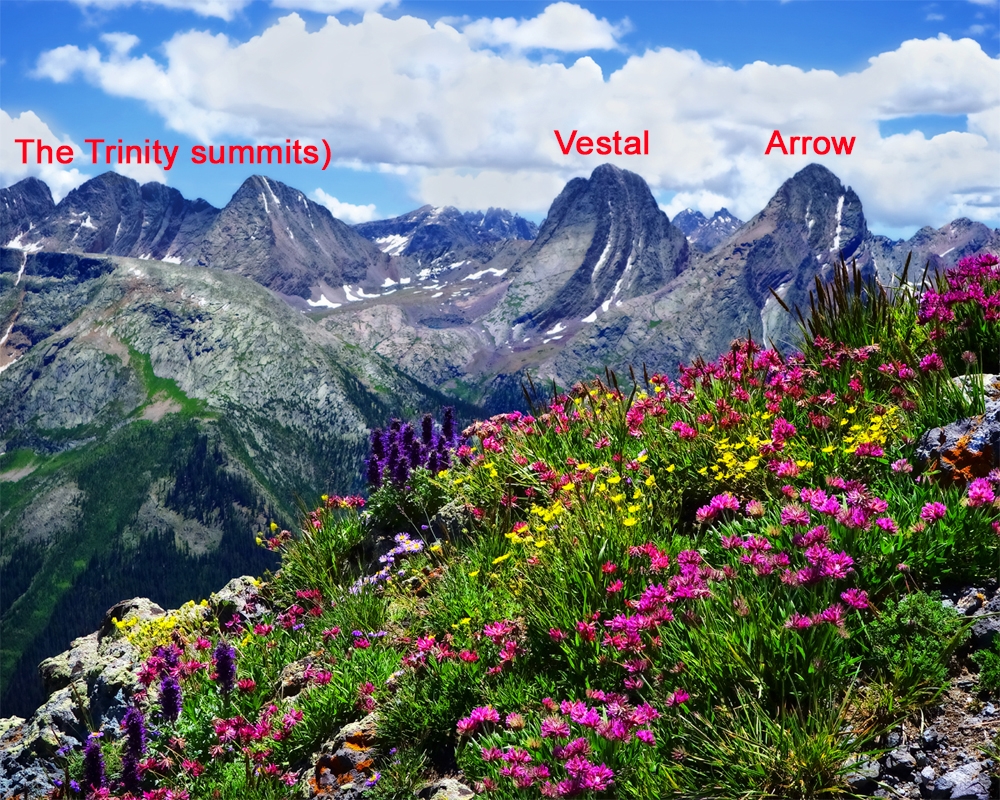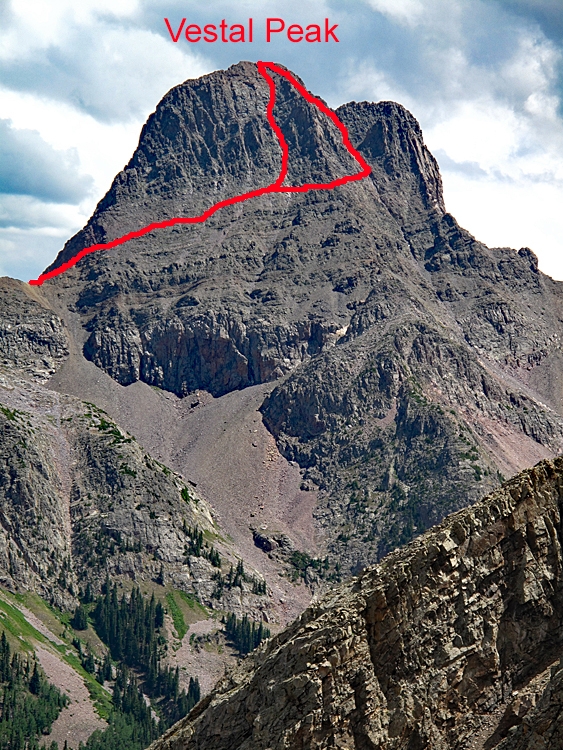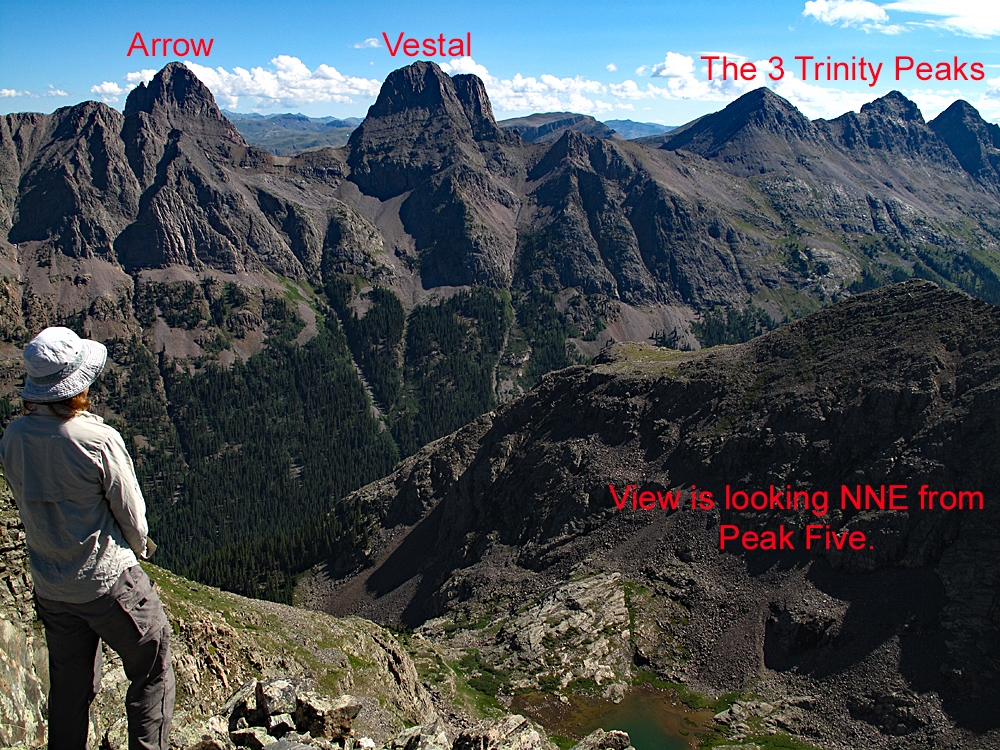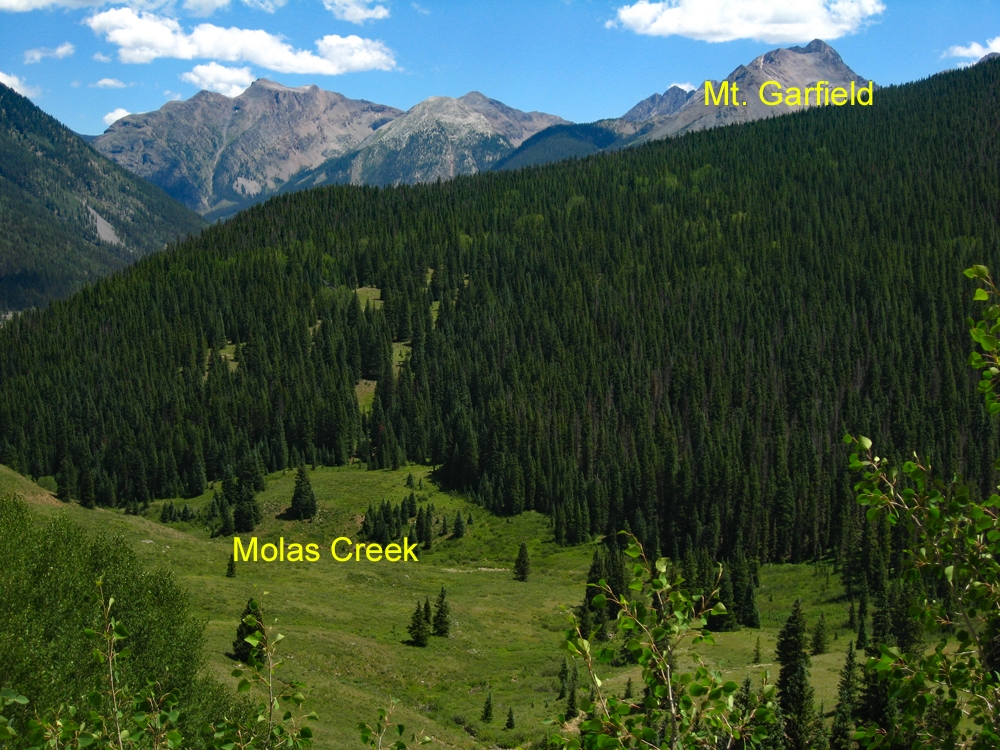LoJ: #78 (Pre-LiDAR #77) / 13,867' Vestal Peak
Peak Summary
Vestal Peak South Face Route
-
Trailhead
Approach Map Photos
-
Molas Pass - Elk Park Trailhead
From the highway intersection just west of Silverton, CO, drive south on US550 in the direction of Molas Pass for 5.3 miles. About .6 mile, or at 5.3 miles total, after the turnoff for the Molas Lake there is a turnoff to the left into the trailhead parking area, accessible to 2WD vehicles. The dirt parking lot may be muddy at times and have a few potholes to avoid. There is usually plenty of room to park here, but can get a little full on weekends.
If coming from Durango, drive north on US550 over Coal Bank Pass and Molas Pass. After cresting Molas Pass, the turnoff for the trailhead will be 1.1 mile further north and on the right. The drive from Durango will take about an hour.
Camping
You can probably vehicle camp at the trailhead but there is no immediate toilet facility. You could also hike south along the trail a short distance from the TH and pitch a tent. There is a vault toilet back at the top of Molas Pass or at the turnoff for Molas Lake, you can drive down to the park and pay a fee to camp where there are not only vault toilets, but also hot showers for $5.00. There is also a fee campground at "Little Molas Lake," which is on a graded dirt road that turns off to the west, from the highway back towards Molas Pass. So overall, there are plenty of camping opportunities in the immediate vicinity.
-
From Molas Pass - Elk Park TH via Vestal Creek Campsite @ 11,760
-
Molas Pass to Elk Ck. Beaver Ponds Moderate | RT: 13 mi / 1,100’
From the Molas Trailhead parking, head south on a connector trail that joins the Colorado Trail about a half mile south of Molas Lake. Follow the Colorado Trail #665 east through mostly open, flowering meadows with enticing views of the Grenadier Range and Snowdon Peaks to the south. The trail maintains elevation as Molas Creek begins to drop away, enters a section of forest and then breaks out of the forest to begin a long descent to the Animas River. Each time we have hiked this section of trail, we have attempted to count the number of switchbacks and each time we have come up with a different number. Suffice it to say there are a minimum of 30. On your way down, enjoy spectacular views of Mount Garfield, Graystone and Electric peaks. From the trailhead to the crossing of the Animas, it's approximately 3 miles.
Eventually the trail deposits you at an easy crossing of Molas Creek (where you can cool your feet from the arduous descent) and then shortly after comes to a well built footbridge across the Animas. Total elevation loss is around 1,700 feet. Once across the Animas, follow along the tracks south and watch for the Elk Creek trail just a short distance away heading up the slope on your left above the tracks. The trail switchbacks up and then begins a contouring path above the tracks over to a low ridge and then Elk Creek. Just before it swings into the Elk drainage, there's a trail that drops back down on the right to some campsites. Once in the Elk Creek drainage, the trail stays on the north side of the creek all the way to the well-known beaver ponds. It's a 3.5 mile hike to there. The trail is well-used and easy to follow and receives regular maintenance. We recall maybe one or two other places where the trail gets close to the creek that would offer a campsite. There are perhaps a couple of spots where the trail crosses a sloping embankment and degrades some. A little over a mile before the beaver ponds, the trail begins to climb above the creek, goes up a side drainage briefly and then gains a flatter bench high above the creek. Once you each that bench, you're less than a half mile from the ponds and the elevation gain is over.
Continue on to the beaver ponds which will be on the right (south side of the trail). There are camp spots right along the trail here, but there are better spots if you cross the ponds on a trail that passes right along the eastern edge of the main pond at the foot of a boulder field. The trail wanders through a few willows, then breaks out into a clearing with several flat campsites on the edge of the trees. This same trail is what you will follow to get to the Elk Creek crossing and then begin a hike up to Vestal Creek and Vestal Basin. On our last visit here in 2011, we saw a cow moose and her calf.
Campsite Locations
Beaver Ponds N 37° 43' 14.64", W 107° 36' 28.44"
Open This Approach in a New Window -
Vestal Creek Approach Difficult | RT: 5 mi / 1,800’
From the Beaver Ponds located just below 10,000 feet on the Elk Creek Trail, skirt around the ponds on the east end following a trail that goes right along the edge of the main pond and a boulder field. On the south end, the trail will meander some in willows and then leave the pond to a flat area with good camping. Continue on the trail south towards a steep embankment drop to Elk Creek. Cross the creek on some fallen logs. (In 2011, there were fallen logs across the creek here that made crossing fairly easy, but this could quickly change.) Once on the south side of Elk Creek, follow the trail on a bench westward for a short time before it begins the steep pull up the Vestal drainage. The Vestal Creek trail is not a regularly maintained trail, though we have seen a trail crew on it before, which may explain why the number of fallen trees across the trail seemed less in 2011. Since it is more of a "use" trail, you may find several variations at times. In our opinion, this is one trail that the Forest Service should develop and maintain in order to reduce resource damage.
As the trail heads generally south up the steep mountainside, you may find multiple branches at times. After about a mile, you'll come to the edge of a second avalanche chute. The main trail will follow more directly uphill along the side of a minor ridge on the east side of the chute. There may be another trail near the bottom of the chute that leads over in the direction of Vestal Creek. Avoid that one. If you're diverted by it, you may find you have to bushwhack up the chute to find the main trail again. Past the avalanche chute, the trail still maintains some distance from the creek. When the creek begins to swing SE, the trail will drop to very near the creek in an open meadow area. There's a large, rotting log on the left side of the trail that makes a good rest stop. From this meadow, looking SSW, you'll be viewing directly up the valley between Electric and Arrow. This is the shortest access to Electric, Garfield and Graystone and the easiest place to cross Vestal Creek is right where the trail comes closest.
For those wanting to continue further up valley to the higher camps, continue on the trail back into forest and reach the "lower meadow" at 11,300 feet. There are primitive camping opportunities here and at the east end of the lower meadow, you'll be directly across from the valley between Arrow and Vestal. It is possible to access that valley from the lower meadow camp, but it ain't easy. For those desiring an even higher camp, continue along the Vestal Creek trail another third of a mile to 11,760 ft. and what we consider to be the best campsite—which is in some of the last, open trees and bordering the creek. Across the creek, there's another flat, open meadow with willows. From this camp, access to the col SSW of West Trinity is an easy matter. Also, a contouring ascent west from this camp can lead you back to the valley between Vestal and Arrow. The ridge and saddle that connects those two summits on their south side also provides access to Graystone. Some groups like to include Graystone with Arrow and Vestal as we did, others will include Graystone with a day up Garfield and Electric.
Camping
There are primitive sites in the lower meadow at 11,300 feet, then another site area around 11,700 feet and a third site area at 11,760 ft. on the edge of a higher meadow. Above there, there are no trees but it may be possible to find more campsites in open tundra. There are abundant willows in some places. Another favorite campsite is above treeline, further up at Vestal Lake.
Open This Approach in a New Window
-
Route Map Photos
Route Info Vestal Peak South Face
Click thumbnail to view full-size photo + captionRoute Description
Year Climbed: 1992The following summary will apply to all the peaks accessible from Vestal Creek. These include: Peaks Two and Three, The Trinities, Vestal, Arrow, Electric, Graystone, Point Pun (unranked) and Garfield. In describing the routes for all these peaks, we have used the beaver ponds on the Elk Creek trail as the "base camp" starting point. Mileages and elevation gain are measured from there for each. However, for those with the strength and fortitude, you can continue the backpack portion of the trip by heading up the unmaintained and sometimes confusing Vestal Creek Trail. That hike will be included with each summit in this area as part of the "approach." Not only is the Vestal trail confusing at times with multiple tracks to follow, it is very steep and also harbors a large number of fallen logs to cross. The campsites in upper Vestal Creek are also known for their aggressive and camp-destroying marmots. Protect your food supply accordingly and even your gear as well. In 1992, we had marmots chew their way into our tent, then they both slept and defecated on our sleeping bags. In addition, they completely destroyed a pair of shorts we had left outside to air out, chewed on our packs and socks left out and they chewed through one of the tubes for our water filter. In short, they were attracted to anything that had salt on it.
To climb Vestal, use the same description as the route for Graystone by beginning from either the "lower meadow" along Vestal Creek at 11,300 feet or from the higher camp at 11,760 ft. From the lower meadow camp, you'll need to ascend SSW steeply for 600 feet to gain the valley between Arrow and Vestal. At the time we did this in 1992, it was something of a bushwhack that will take you through trees, willows, rock benches and minor cliffs, and tundra. Roach describes a "strong climber's trail" heading into the basin now. In 1992, we saw no evidence of such. If coming from the higher camp, you'll need to contour back to the west across rock benches interspersed with tundra and grassy shelves to the same valley. Once in the valley between Arrow and Vestal, head SSW to the saddle that joins the two peaks. Most of this valley is occupied by a rock glacier with little tundra for reprieve from the relentless boulder hopping, etc. Obtaining the saddle will take you through talus & scree as well, or possibly snow earlier in the season. Ice axe would be handy then.
From the Arrow/Vestal saddle head east on a probable climber's trail with cairns that makes a contouring ascent along the lower west ridge and south face of Vestal. Stay below the cliffs at about 13,200 ft. At the time we climbed this, the only sources we used were Garratt and Martins book (and Rosebrough's book) which recommended contouring until directly south of the summit and then ascending up a shallow couloir. We found a substantial cairn in the vicinity of this couloir but were not sure if the cairn meant "head up here" or just "keep going, you're on the right path." The couloir was so shallow as to not really appear as one at this point, so we continued contouring east until we came to a very prominent couloir filled with snow (early July). This we felt was the recommended couloir in Rosebrough's "San Juan Mountains" book. Not having crampons for the steep snow, we decided to ascend here, staying on the west side of the couloir on mostly Class 2+ rock with perhaps a few minor Class 3 moves thrown in. Gaining the summit was no problem, but we did come out on a ridge a little east of the true summit. This confirmed to us that we had come up by the Rosebrough route, which is the great couloir on the SE face of the peak. In Roach's book, this is described as the "Vestal Peak - South Face route." Roach offers a few more details regarding this section than we, if you need more, but the route is really straightforward. When you arrive at the summit, you can break out in exaltation at having ascended the highest of the Grenadier peaks and at having climbed a Top 100 summit. Wander around a little to get a good view looking down the Wham Ridge. It is a sight to behold. Descend by the same route.
A note about the topography of Vestal Peak, noted by both G&M and Roach. The original 1964 USGS Storm King Peak survey map of this area had Vestal listed at 13,664 ft. with 200 feet of mountain missing from the contours. A "photo-inspected" version of the Storm King quad released in 1975 gave a corrected elevation of 13,864 ft. and then tried to cram in additional contour lines for that missing 200 feet of mountain. Examining the map gives the impression that the last 200 feet of mountain is extremely steep and possibly technical. In reality, the percent grade to the top is pretty much the same. This original error is recreated on the Trails Illustrated map which lists the incorrect elevation and does not show the missing contour lines. I've tried contacting their cartographers before about other map errors and have been ignored. What I find rather curious is how Google Earth shows this peak, for it seems to represent the last 200 feet as much steeper than the lower terrain. So in the Google Earth photo, take what you see with a grain of salt.
Additional BETA
Links to other information, routes & trip reports for this peak that may be helpful. -

